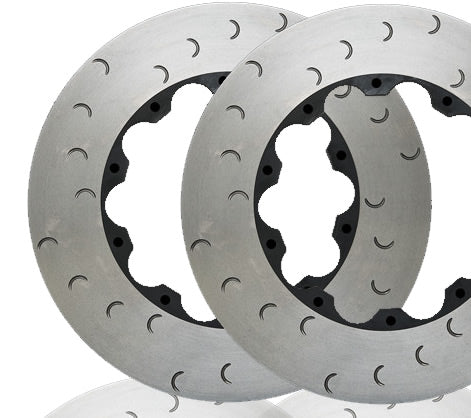630.360.2548


So you've decided on a big brake kit - but in the case of the systems offered at Alconkits.com you will see there are usually multiple sizes of rotors to choose from.
So which rotor size should you choose?
The first factor is the wheel size. Our common rotor sizes of 343mm, 355mm, and 380mm rotors, the minimum wheel diameter is 17", 18", and 19" respectively. Naturally most people want the largest rotor they can find, because it generally provides more braking torque and, frankly, looks better.
But do you always want to choose the largest diameter rotor you can fit?
In simple terms, the idea that "bigger is better" applies to brakes on cars. However, this philosophy comes with a cost—both in terms of money and the added weight.
Frequently most of our brake systems, regardless of rotor diameter, can outbrake the grip of the tires, so for non competition use, this isn't really a huge factor though. ...but for heavy duty applications larger rotors also provide a place to temporarily store heat. Heat is the worst enemy of braking.
Larger rotors have more surface area to cool, making them more resistant to brake fade and more thermal mass, meaning it can store more heat. The larger diameter provides a mechanical advantage even after fade sets in, resulting in better performance under braking stress.
There are different types of rotors—vented, slotted, and drilled—that improve cooling and resistance to fade. Vented rotors are the best for cooling, while slotted and drilled rotors help prevent fade. Fade occurs when the brake pads heat up, creating gas pressure between the pad and rotor. The slots and holes in slotted and drilled rotors provide an outlet for the gas, reducing fade compared to solid rotors.
If you compare a smaller vented, slotted, and drilled rotor to a larger solid rotor, the smaller one will be lighter. However, the optimal balance between weight and performance is not always straightforward. Vented, slotted, and drilled features add to the cost, but having more material and weight also increases the cost.
In racing cars, you often find vented, slotted, and drilled rotors because they experience frequent braking with minimal cooling time, leading to rapid heat buildup. If you watch a Formula 1 race at dusk, you might even see the brake rotors glowing red-hot. Regular cars, on the other hand, typically have fewer stops from top speed, allowing for more cooling time between braking events.
Of course its not just about the rotor size. Phil Stubbs, president of Alcon US discusses some other factors to consider:
So, what to choose?
Generally we would recommend selecting a rotor that is as large as you can safely fit in the wheel. Unsprung weight increases, but modern suspension systems are much more capable of managing this.
The reason we suggest a larger rotor is for the heat capacity. Smaller rotors will stop very well the first few times, but with heat buildup through repeated hard stops, they will lose performance faster than a larger rotor.
